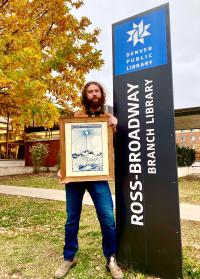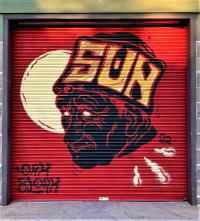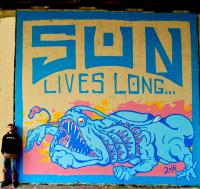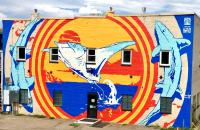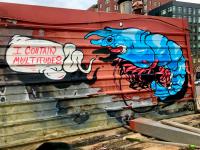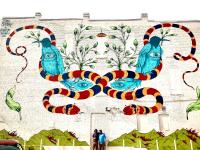Often, dark alleys and cityscapes can be credited for inspiration in street artists, but occasionally it’s America’s back country that can begin the stories of some of most colorful murals that reside in Colorado. Enter Max Michael Coleman aka Oak Bloak, an artist who began his life between the wooded shores of Connecticut and the magnificent peaks of northern Colorado. Graduating from the Rhode Island School of Design in 2015, Max’s work seeks to take elements and techniques of centuries past, and apply them towards the modern day mediums of digital illustration and street art. Through the vehicle of his "SUN Lives Long" campaign, his murals and prints have taken an active stance towards promoting equality and awareness for the creatures of earth, as well as to impart a sense of kinship towards the planet. His work is able to sit comfortably in the present while at the same time harkening the viewer back to some anachronistic era of the past.
We were lucky to catch Max on the way back from one of his trips out east so that we could get the bottom of what sort of books an Oak Bloke is inspired by.
Learn more and follow Oak Bloak:
Instagram | Website
Oak Bloak on Art, Books, and Libraries
- What book as a kid influenced your imagination to pick up a crayon and begin making art?
My family is Jewish, and my mother gave me MAUS as a boy. But only the beginning chapters.
At the time I didn’t fully understand the power of those simple drawings of Jews as mice and Nazis as cats, that would come with age. But I remember thinking, “To be an artist is an option. An adult made this book” I could make a way in the world.
- What book are you currently reading that influences you in either a creative way or a professional way?
Funny enough: After maybe 15 years I finally DID read the entirety of MAUS. Which should be required reading for every adult and child.
This book serves as a historical document, attesting to the truth of what happened during the holocaust. All through drawing, and all in a format no one could have imagined at the time. The seed that this book planted in me so many years ago I feel has been rejuvenated. Perhaps transplanted. I feel an urge to make art that broadens perspective and educates.
- What do you think is the most important resource that Libraries provide to you as an artist?
The complete lack of censorship, It presents the truth to those seek it, and as an artist I want the truth. Because history and life are important, and in my work I strive to hold up either a mirror to reflect, or a portrait to declare what I think about both. In this way I can challenge what is called beautiful, and call action towards things that need help.
I have always wanted to present the world with unflinching images, as the history books in a library do, and art that explores that which we’ve deemed terrifying or morbid. I think only through that can we be united in mental AND physical peace.
- What is your current/favorite/most-used branch of the Denver Public Library?
I always liked the presence of the Central Branch on 13th but my closest Branch is the Ross-Broadway Branch and I like its hustle of being a small branch in such a growing and diverse neighborhood.
- If you were offered a gigantic wall on the outside of a Library, what would your paint to display what a library means to you?
I would write in huge letters, “In truth and knowledge there is ultimate strength.” Accompanied by a hand stretching above the mountains towards the sun holding a pen. I would paint it so light and warmth radiated from behind the tip of the pen. Because all the books in these buildings were written with human hands, and each wanted to impart something meaningful before they passed on. This wall would be a grand monument to them, and the noble buildings that house their contributions to not only our city, but to the world.
Ex Libris: Denver Artists is a series featuring local street artists, focusing on their connection to books and the importance of libraries to the artistic community. Series concept and interview by Sean Ryerson.

